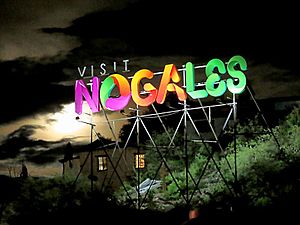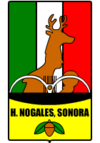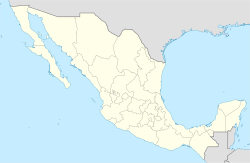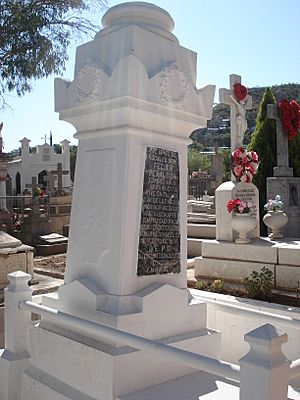Heroica Nogales facts for kids
Quick facts for kids
Nogales
|
||
|---|---|---|
|
City
|
||
| Heroica Nogales | ||

Signboard of 'Visit Nogales'
|
||
|
||
| Country | Mexico | |
| State | Sonora | |
| Municipality | Nogales | |
| Founded | July 9, 1884 | |
| Founded by | Luis Emeterio Torres | |
| Elevation | 1,199 m (3,934 ft) | |
| Population
(2020)
|
||
| • Total | 264,782 | |
| Demonym(s) | Nogalense | |
| Time zone | UTC-7 (MST) | |
| • Summer (DST) | UTC-7 (No DST observed) | |
| Area code(s) | 631 | |
Heroica Nogales, often called Nogales, is a city in the Mexican state of Sonora. It is the main city of the Municipality of Nogales. The city is right on the border with the United States. It sits next to Nogales, Arizona, in the U.S.
The name "Nogales" means "walnut trees" in Spanish. In 2020, about 264,782 people lived in the municipality.
Contents
History of Nogales
The independent Nogales Municipality, which includes the city of Nogales, was created on July 11, 1884. The municipality covers an area of 1,675 square kilometers. Nogales officially became a city on January 1, 1920.
The Battle of Ambos Nogales
Trade between Heroica Nogales and Nogales, Arizona helped Nogales grow a lot. But problems started after the Mexican Revolution began in 1910.
On August 27, 1918, a fight broke out by accident. A Mexican person tried to cross the border back into Mexico without checking in with U.S. Customs. After the first shots, more people from both sides rushed to the border. On the Mexican side, many civilians were upset because U.S. Army soldiers had killed Mexican border crossers. On the American side, soldiers and civilians joined the fight.
The fighting quickly got worse, and soldiers were killed or hurt on both sides. The mayor of Nogales, Sonora, Felix B. Peñaloza, was killed while waving a white flag to stop the fighting.
After this battle, the first permanent border fence was built between the two cities of Nogales. In 1961, the leaders of Nogales, Sonora, asked the Mexican Congress to give the city the title "Heroic City." This is why its official name is Heroica Nogales.
The Escobarista Rebellion
In March 1929, a conflict called the Escobarista Rebellion happened in Nogales. This rebellion was supported by people who followed Mexican president Álvaro Obregón, who had been killed in 1928.
General Manuel Aguirre took control of Nogales without a fight. Soldiers from Naco, a nearby town, sent an airplane to attack the rebels every day. The plane dropped a few bombs, but they didn't cause much damage. The rebels shot back with machine guns from rooftops, but they also didn't hit the plane. Only one person was hurt: a woman who had a heart attack from fear.
Later that month, a mysterious person drove a tank from the U.S. side into Mexico to help the soldiers in Naco. This tank was bought in 1927 to fight the Yaquis, but U.S. officials had stopped it from leaving the U.S. It had been stored in a warehouse in Nogales, Arizona.
Climate and Weather
Nogales has a semi-arid climate. This means it has hot summers and cool winters. Temperatures often drop below freezing in winter.
| Climate data for Heroica Nogales, Sonora (1981-2010, extremes (1963-present) | |||||||||||||
|---|---|---|---|---|---|---|---|---|---|---|---|---|---|
| Month | Jan | Feb | Mar | Apr | May | Jun | Jul | Aug | Sep | Oct | Nov | Dec | Year |
| Record high °C (°F) | 31.0 (87.8) |
32.0 (89.6) |
36.0 (96.8) |
40.0 (104.0) |
44.0 (111.2) |
46.0 (114.8) |
43.0 (109.4) |
43.0 (109.4) |
39.0 (102.2) |
39.0 (102.2) |
33.0 (91.4) |
29.0 (84.2) |
46.0 (114.8) |
| Mean daily maximum °C (°F) | 17.8 (64.0) |
18.1 (64.6) |
21.0 (69.8) |
24.9 (76.8) |
29.3 (84.7) |
34.1 (93.4) |
33.5 (92.3) |
32.1 (89.8) |
30.7 (87.3) |
26.4 (79.5) |
21.2 (70.2) |
17.3 (63.1) |
25.5 (77.9) |
| Daily mean °C (°F) | 10.1 (50.2) |
10.6 (51.1) |
13.1 (55.6) |
16.6 (61.9) |
20.8 (69.4) |
25.6 (78.1) |
26.4 (79.5) |
25.3 (77.5) |
23.4 (74.1) |
18.8 (65.8) |
13.5 (56.3) |
9.9 (49.8) |
17.8 (64.0) |
| Mean daily minimum °C (°F) | 2.3 (36.1) |
3.1 (37.6) |
5.2 (41.4) |
8.2 (46.8) |
12.3 (54.1) |
17.0 (62.6) |
19.3 (66.7) |
18.5 (65.3) |
16.2 (61.2) |
11.1 (52.0) |
5.8 (42.4) |
2.5 (36.5) |
10.1 (50.2) |
| Record low °C (°F) | −10.0 (14.0) |
−9.0 (15.8) |
−9.0 (15.8) |
−4.0 (24.8) |
−2.0 (28.4) |
0.0 (32.0) |
11.0 (51.8) |
8.0 (46.4) |
6.0 (42.8) |
−3.0 (26.6) |
−4.0 (24.8) |
−10.0 (14.0) |
−10.0 (14.0) |
| Average precipitation mm (inches) | 24.7 (0.97) |
27.7 (1.09) |
19.5 (0.77) |
8.1 (0.32) |
5.0 (0.20) |
10.0 (0.39) |
110.5 (4.35) |
115.1 (4.53) |
52.0 (2.05) |
32.7 (1.29) |
21.5 (0.85) |
28.1 (1.11) |
454.9 (17.91) |
| Average precipitation days (≥ 0.1 mm) | 3.5 | 3.5 | 2.6 | 1.4 | 1.2 | 1.6 | 10.1 | 9.9 | 4.8 | 2.6 | 2.6 | 3.5 | 47.3 |
| Source: Servicio Meteorologico Nacional | |||||||||||||
People and Population
In 2020, the Nogales Municipality had 264,782 people. This shows a lot of growth since 1990.
About 1,980 people in Nogales spoke a Native language in 2020. The most common was the Mayo language, with 1,024 speakers. There were also 2,410 documented immigrants, mostly from the United States.
In 2020, 71% of homes had internet, and 95.6% had at least one cellphone. More than half of adults (53.2%) had a high school diploma or college degree. This number has grown quickly since 2000.
Nogales has a low Gender Inequality Index (0.33). This means there is more fairness between genders here than in other parts of Sonora. Also, less than 30% of people lived in poverty in 2020, which is lower than Mexico's average.
Nogales is the third largest city in Sonora by population. Only Hermosillo and Ciudad Obregón are bigger. The municipality also includes smaller towns like La Mesa (2,996 people) and Centro de Readaptación Social Nuevo (2,203 people). Nogales International Airport serves the city.
The city has grown a lot because of new factories. These factories started opening decades ago, even before the North American Free Trade Agreement (NAFTA). Manufacturing now makes up 55% of the city's total economic output. Service jobs are also growing.
Nogales has grown so much that houses now cover the hills around the central valley. You can find factories and stores mixed in with the homes. In 2006, the southern part of the city developed with new shopping malls, wide roads, and modern housing.
City Monuments
In the center of Nogales, you will find the Plaza de Benito Juárez. This plaza has a statue created by Spanish sculptor Alfredo Just. One part of the statue honors Mexican President Benito Juárez. The other part is called the "Monument to Ignorance." It shows a man, representing the Mexican people, fighting a winged creature that stands for ignorance.
Economy and Trade
Getting Around Nogales
The main road for business is Mexico Federal Highway 15. This highway connects Nogales to other big cities in Mexico. It also links to Interstate 19 at the U.S. border.
For air travel, the city uses the Aeropuerto internacional de Nogales. As of 2015, this airport did not have regular passenger flights.
Visiting Nogales
Nogales is an important entry point for tourists from the U.S. Its downtown area has many bars, hotels, and restaurants. There are also many souvenir shops. These shops sell a variety of artesanías (handicrafts, leather art, handmade flowers, clothes) from central and southern Mexico.
You can find many local dishes in restaurants. These include antojitos (Mexican snacks) like enchiladas, tacos, burritos with carne machaca (dried meat), menudo, and tamales.
Manufacturing in Nogales
Maquiladoras, or manufacturing plants, employ a large number of people in Nogales. Because Nogales is close to the U.S. and has many workers, it's a good place for foreign companies to build and assemble products. Some companies with factories here include Continental AG, Amphenol Corporation, and ABB.
What Nogales Makes and Sells
About 92 factories in Nogales make products for export to other countries. Sixty-five of these factories are in seven industrial parks. They employ about 25,400 workers. This is about half of all the jobs in the municipality. Raising livestock (farm animals) for export and breeding is also important to the economy.
Farming and Produce
Fresh produce is one of Mexico's biggest exports to the United States. The Mariposa Port of Entry in Nogales is the most used route for this produce. Currently, 37% of all produce imported from Mexico to the U.S. comes through Nogales. In winter, this number jumps to about 60%.
In 2020, about $3.7 billion worth of fresh produce entered the U.S. through Nogales. Much of this produce came from the Mexican states of Sonora and Sinaloa. The top products shipped through Nogales in 2021 were tomatoes, watermelon, cucumbers, and squash.
The produce industry needs places to store, pack, and transport these goods. This creates many jobs on both sides of the border. The busiest time for harvesting and importing is from November to March.
Gallery
-
Monument to the Ninos Heroes
-
Monument to president Benito Juárez.
Religion
Since March 13, 2015, the Catedral Santuario de Nuestra Señora de Guadalupe has been the main church for the Roman Catholic Diocese of Nogales. It is part of the larger Archdiocese of Hermosillo.
Notable People from Nogales
- Ana Gabriela Guevara: A world champion in athletics (running) in 2003 and an Olympic silver medalist in 2004.
- David Zepeda: An actor, singer, model, and lawyer.
- Óscar Valdez: A professional boxer and two-time Olympian. He was a world champion in both featherweight and super featherweight boxing.
- Esthella Provas: An art dealer.
See also
 In Spanish: Heroica Nogales para niños
In Spanish: Heroica Nogales para niños
















